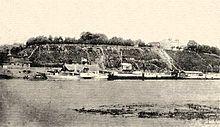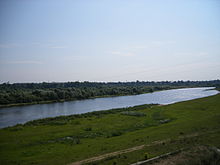Sozh
| Sozh | |
|---|---|
 | |
 | |
| Native name |
|
| Location | |
| Country | Belarus,Russia,Ukraine |
| Physical characteristics | |
| Source | |
| • location | Russia |
| Mouth | |
• location | Dnieper |
• coordinates | 51°56′50″N30°48′24″E/ 51.94722°N 30.80667°E |
| Length | 648 km (403 mi) |
| Basin size | 42,140 km2(16,270 sq mi) |
| Discharge | |
| • average | InGomel:207 m3/s (7,300 cu ft/s) |
| Basin features | |
| Progression | Dnieper→Dnieper–Bug estuary→Black Sea |

TheSozh(Belarusian:Сож,romanized:Sož,[1]IPA:[sɔʐ];Russian:Сож;Ukrainian:Сож) is a river flowing inRussia,Belarus,andUkraine.It is a left banktributaryof theDnieper.The Sozh passes throughGomel,the second largest city in Belarus.[2]
The river is crossed by theSozh Floating BridgeatKormaand an elegantsteel archat Gomel, which is featured on aRbls300 national stamp.[3]
Etymology
[edit]The original name was Sozh' (Russian:Сожь), fromOld East SlavicСъжь. With the previously suggestedBalticandFinnicetymologies considered unsatisfactory, Vadim Andreevich Zhuchkevich proposed that the name is derived from Old Russian/Old Belarusiansozhzh'(сожжь) 'burned parts of a forest prepared for plowing,' which has parallels to other place names.[4]
Geography
[edit]
The Sozh rises in Russia and is mostly snow fed. The river freezes over between November and early January. The ice thaws from late March or April. TheVikhraandPronia,on the right, and theOstyor,Besed,IputandUtson the left are its main tributaries.[2]It is one of the six tributaries longer than 500 km that join theDnieper– the third longest river in Europe at 2,201 km.[5]
The Sozh hasnavigational locksin its upper reaches where it is navigable fromKrychaw.Timber is floated along the river.[2]
The mouth of the river is 150m broad and swampy. The catchment area of the river is 42,140 square kilometres (16,270 sq mi) along its 648 kilometres (403 mi) length, 21,700 square kilometres (8,400 sq mi) and 493 kilometres (306 mi) within Belarus.[6]The mean discharge recorded at Gomel, 100 kilometres (62 mi) upstream from the mouth, is 207 m3/s.[2][7]
Important historical towns on the banks of the main river and its tributaries are:Krychaw,Cherykaw,Slawharad,GomelandVietka.[2][8]: 209 [9]
In Russia, the Sozh has its source inSmolensky Districtand flows throughPochinkovskyandKhislavichsky Districtsof Smolensk Oblast. Theurban-type settlementofKhislavichiis located on the banks of the Sozh. It flows further south, making the border between Khislavichsky andShumyachsky Districtof Smolensk Oblast in the east, and Mogilev Region of Belarus in the west.
History
[edit]
Many of the cities and towns located in the river valley are part of the river's history of events. Several centuries ago, theEast SlavicRadimichitribal people lived in the Sozh River basin and established the Gomel town. The They were involved in agricultural practices, rearing cattle, fishing and honey collection. They were craftsmen, and they were good tradesman as the river provided navigation to the northwestern and southeastern parts ofEurope.[10]Gomel, a river port and a railhead, is also known as Homyel or Homiel. It is situated to the southeast of Belarus, and is the capital (administrative centre) of theGomel Region.It is located on the western bank of the Sozh River, about 300 km fromMinsk,and close to the border with Russia and Ukraine. The earliest reported occupation of the town was in 1142, under Kievan Rus. This was followed byLithuaniancontrol in 1537, thenPolishunder theTruce of Andrusovo,and later underRussiain 1772. Embankments were built on the banks of the Sozh River. As a result, "a unique nature-architecture ensemble grew on the high picturesque bank of the Sozh River right in the historical center of Gomel." These monuments are credited to theRumyantsevsand thePaskevicheswho were statesmen and military commanders of the Russian Empire.[11]The town is now an important industrial center with a population of about half million.[8]: 197 [12][13]Located in the region of theChernobyl disaster,Gomel and its surrounding area still suffers from subsisting levels of radiation.[8]: 197

Vetkais a small town, 22 kilometres (14 mi) northeast of Gomel, surrounded by forest and marshy land. It was gutted twice by invadingTsaristforces in 1735 and 1764 which forced the residents to resettle in Eastern Russia. It was renowned for the unique icon style paintings and also wood carvings. It was annexed by theRussian Empire,in 1852. Ships were manufactured here from 1840. DuringWorld War II,the town was occupied by theNaziswho killed many of the residents. Vetka, on the Sozh River, is located in an arearadioactively pollutedas a result of theChernobyl disasterthat occurred on 26 April 1986.[14]High radiation levels due toiodine-131(20,000 kBq/m2) andstrontium-90(137 kBq/m2) were measured in the soil in the entire Vetka district after the accident.[15]This disaster also resulted in a large-scale relocation of population. A Folk Art Museum, founded in 1987, has exhibits depicting the ancient artefacts, carved wooden entrance doors, manuscripts, traditional costumes and wovenrushniki.[8]: 209
Anthropomorphized forms of Russian myths include tales of rivalry between the Sozh, described as wild and turbulent, and the Dnieper, which is described as quiet and leisurely.[16]
Archaeological excavations
[edit]Excavations have unearthed aPalaeolithicboat in the soils of the Sozh River, which has been preserved in the Museum of Ancient Belarusian Culture.[8]: 118 The remains of pantheist temples were excavated in the mounds of Tushemlia andHaradokon the Sozh River and dated to the 3rd and 4th centuries. These temples have been inferred as temples erected byBaltsfor worship of gods and goddesses. Through the end of the 14th century, during theGrand Duchy of Lithuaniaperiod,pantheistic religionwas prevalent in the region.[17]Another Palaeolithic site, discovered byKonstantin Mikhailovich Polikarpovich,is located on the hill above the bank of Sozh river, in Berdizh village.[18]Remains ofwoolly mammothhave also been found along the Sozh River.[19]
Economy
[edit]Sozh River deposits that extend intoSmolensk Oblastproviding a supply of groundphosphatetoKrychawandKlimavichyrock plants.[20]Phosphoriteis found along the river between Mstislavl and Krichev. Many other construction materials, such as chalk, clay, sand, and gravel are also distributed in the river region as are many mineral water springs.[9]The Sozh is one of the two chief rivers ofMogilevin the Smolensk Oblast where the trade in the early part of the 20th century, involving primarily paper, oil, wire nails, flour, glass, and matches, was predominantly in the hands of the large Jewish population.[21]
Tributaries
[edit]Main tributaries:Vihra,Oster,Pronya,Besed,Iput,Khmara,Peschanka.
References
[edit]- ^official transliteration
- ^abcde"Sozh".The Great Soviet Encyclopedia, 3rd Edition (1970–1979).Retrieved2 February2011.
- ^"Bridges of Belarus".FSU Postage Stamps Catalogue.Retrieved2 February2011.
- ^Pospelov, Evgenij Michajlovič (1998).Geograficeskie nazvanija mira: toponmiceskij slovar(in Russian). Moskav: Russkie Slovari. p. 390.
- ^Klement Tockner; Urs Uehlinger; Christopher T. Robinson (2009).Rivers of Europe.Academic Press. pp. 522–.ISBN978-0-12-369449-2.Retrieved3 February2011.
- ^"Main Geographic Characteristics of the Republic of Belarus. Main characteristics of the largest rivers of Belarus".Land of Ancestors.Data of the Ministry of Natural Resources and Environmental Protection of the Republic of Belarus. 2011.Retrieved27 September2013.
- ^"Dnieper River".Encyclopedia of Ukraine.1984.Retrieved2 February2016.
- ^abcdeNigel Roberts (2008).Belarus.Bradt Travel Guides.ISBN978-1-84162-207-1.Retrieved2 February2016.
- ^ab"Belarus City".Belaruscity.net.Retrieved2 February2011.
- ^"Gomel: Then & Now: Gomel's History".Gomel.lk.net. Archived fromthe originalon 3 February 2012.Retrieved2 February2011.
- ^"The levee of the Sozh River".Gomel Palace & Park Ensemble. 2009.Retrieved2 February2011.
- ^"Homyel".Encyclopædia Britannica.Retrieved2 February2011.
- ^"Gomel".Encyclopedia.Retrieved2 February2011.
- ^"Vetka".Belarus tourism- A national Tourism Agency. Archived fromthe originalon 6 July 2011.Retrieved2 April2011.
- ^"Vetka District".chernobyl.info. Archived fromthe originalon 22 November 2010.Retrieved2 April2011.
- ^Warner, Elizabeth (1 July 2002).Russian myths.University of Texas Press. pp. 24–.ISBN978-0-292-79158-9.Retrieved5 February2011.
- ^"Heavenly Bodies and Phenomena in the Baltic Religion".Romuvainfo. Archived fromthe originalon 6 September 2010.Retrieved2 February2011.
- ^Tage Skogsberg; Austin Phelps (1938).Hydrography of Monterey Bay California: Thermal conditions.American Philosophical Society.Retrieved3 February2011.
- ^Kipfer, Barbara Ann (2000).Encyclopedic dictionary of archaeology.Springer. p. 65.ISBN978-0-306-46158-3.Retrieved5 February2011.
- ^Lamer, Mirko (1957).The world fertilizer economy.Stanford University Press. p. 377.ISBN978-0-8047-0474-8.Retrieved5 February2011.
- ^New international encyclopedia.Dodd, Mead. 1916. p. 95.Retrieved7 February2011.

